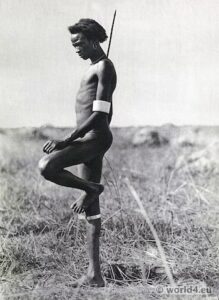
A Nuer African Man
*The Nuer African community are affirmed on this date in 1500. The Nuer are a Nilotic ethnic group concentrated in the Greater Upper Nile region of South Sudan.
They also live in the Ethiopian region of Gambella. The Nuer speak the Nuer language, which belongs to the Nilo-Saharan language family, specifically the Nilotic branch. They are the second-largest ethnic group in South Sudan and the largest ethnic group in Gambella, Ethiopia. The Nuer people are pastoralists who herd cattle for a living. Their cattle serve as companions and define their way of life. The Nuer call themselves "Naath." The Nuer people are said to have originally been a section of the Dinka people that migrated out of the Gezira south into a barren, dry land that they called "Kwer Kwong," which was in southern Kordofan.
Centuries of isolation and influence from the Luo people led to them being a distinct ethnic group from the Naath. The arrival of the Baggara and their subsequent slave raids in the late 1700s prompted the Nuer to migrate from southern Kordofan, now centered around Bentiu. In around 1850, further slave raids, as well as flooding and overpopulation, caused them to migrate even further out of Bentiu and eastwards into the western fringes of Ethiopia, displacing and absorbing many Dinka, Anyuak, and Burun in the process. British colonial expansion in the region during the 19th Century greatly halted the Nuer's aggressive territorial expansion.
There are different accounts of the origin of the conflict between the Nuer and the Dinka, South Sudan's two largest ethnic groups. Anthropologist Peter J. Newcomer suggests that the Nuer and Dinka are similar. He argues that hundreds of years of population growth led to expansion, which eventually gave rise to raids and wars. In the early 1990s, approximately 25,000 African refugees were resettled in the United States across various locations, including South Dakota, Tennessee, and Minnesota. Four thousand two hundred eighty-eight refugees from Sudan were resettled in 36 different states between 1990 and 1997, with the highest number in Texas, accounting for 17 percent of the Sudanese refugee population.
The Nuer refugees in the United States and those in Africa continue to observe their social obligations to one another. They use various means, ranging from letters to technologically advanced communication methods, to stay connected to their families in Africa. Nuer in the United States aid with family members' paperwork to help their migration process to the United States.
Nuer in the United States observe family obligations by sending money to those still in Africa. Typical foods eaten by the Nuer tribe include beef, goat, cow's milk, mangos, and sorghum in one of three forms: "ko̱p" finely ground, handled until balled and boiled, "walwal" ground, lightly balled and cooked to a solid porridge, and injera / Yɔtyɔt, a large, pancake-like yeast-risen flatbread. In 2006, the Nuer and Murle were the tribes that resisted disarmament most strongly; members of the Nuer White Army, a group of armed youths often autonomous from tribal elders' authority, refused to lay down their weapons, which led SPLA soldiers to confiscate Nuer cattle, destroying their economy. The White Army was finally put down in mid-2006, though a successor organization self-styled itself as a White Army formed in 2011 to fight the Murle tribe.
The Nuer receive facial markings (called gaar) as part of their initiation into adulthood. The pattern of Nuer scarification varies within specific subgroups. The most common initiation pattern among males consists of six parallel horizontal lines, which are cut across the forehead with a razor, often with a dip in the lines above the nose. Dotted patterns are also common (especially among the Bul Nuer and among females). Some Nuer have begun practicing circumcision after being assimilated or partially assimilated into other ethnic groups. The Nuer are not historically known to circumcise, but sometimes circumcise people who have engaged in incest.